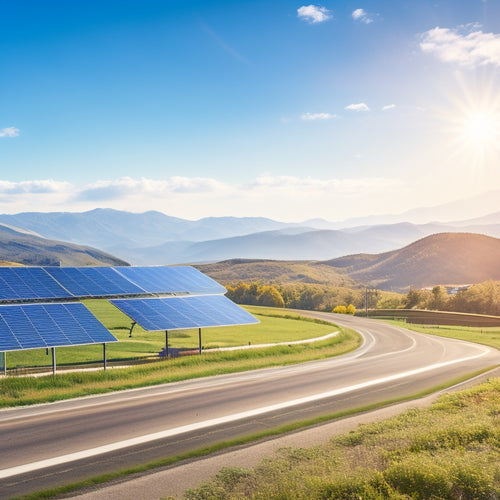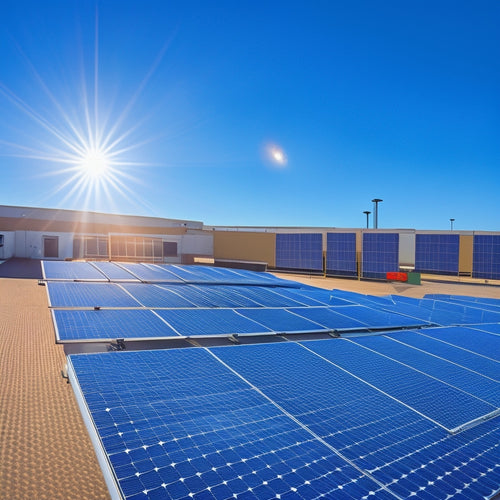
10 Best Home Energy Self-Sufficiency Solutions
Share
You're taking control of your energy consumption and seeking to break free from reliance on the grid, reducing your carbon footprint and saving money on utility bills in the process. To achieve energy self-sufficiency, consider utilizing solar energy with high-efficiency panels, exploring wind power in breezy regions, or employing biofuels for cooking and heating. Energy-efficient home insulation systems, green roofing, and geothermal heating and cooling systems can also greatly reduce energy consumption. Additionally, home battery storage solutions, smart home automation, and energy monitoring systems can optimize energy usage. By implementing these solutions, you'll be well on your way to achieving energy independence, and there's more to uncover as you continue on this path.
Overview
- Invest in solar energy with high-efficiency panels and off-grid power systems for continuous energy supply during low sunlight periods.
- Implement wind power solutions in breezy regions with strategic turbine placement to maximize energy output and reduce transmission losses.
- Utilize biofuels for cooking and heating by converting organic waste into energy, reducing reliance on fossil fuels and carbon footprint.
- Optimize energy efficiency with home battery storage solutions, energy monitoring systems, and automated energy controls to reduce waste and consumption.
- Incorporate sustainable home design and infrastructure features like energy-efficient insulation, green roofing, and geothermal heating and cooling systems to minimize energy needs.
Harnessing Solar Energy for Homes
Your solar-powered home can now become a reality, thanks to advancements in photovoltaic technology and decreasing system costs. You can now capture solar energy to power your home, reducing your reliance on the grid and your energy bills.
With improved solar panel efficiency, you can generate more electricity from the same amount of sunlight, making solar energy a more viable option. Additionally, solar energy incentives, such as tax credits and rebates, can help offset the initial investment costs.
By incorporating high-efficiency solar charging solutions that maximize energy harvest, you can optimize your energy production. Furthermore, investing in reliable off-grid power systems guarantees a continuous power supply during low sunlight periods.
Wind Power for Residential Areas
As you investigate alternative energy sources for your home, wind power emerges as a promising solution for residential areas, particularly in regions with consistent breeze patterns.
To maximize energy output, strategic turbine placement is essential. You'll want to position your turbine in an area with minimal obstruction and ideal wind flow. Consider factors like wind direction, speed, and turbulence when selecting a location.
Proximity to farm infrastructure can also reduce transmission losses, enhancing energy production. A well-placed turbine can generate significant energy output, reducing your reliance on the grid and your energy bills.
With proper installation and maintenance, wind power can be a clean, efficient, and cost-effective way to power your home. By utilizing the wind's energy, you'll be taking a significant step towards energy independence and a more sustainable future.
Energy-Efficient Home Insulation Systems
You're likely aware that a well-insulated home is vital for energy efficiency, but you may not know where to start when it comes to selecting the right materials and guaranteeing proper installation.
To guarantee ideal energy performance, it's important to assess energy needs through total consumption calculation and energy audit, and then choose the right insulation materials.
As you investigate energy-efficient home insulation systems, you'll want to take into account various insulation material options, from fiberglass batts to spray foam, each with its own R-value and installation requirements.
Insulation Material Options
How effectively do modern homes retain warmth in winter and coolness in summer? The answer largely depends on the type of insulation used. As you consider energy-efficient home insulation systems, it's crucial to choose the right insulation material for your needs.
| Insulation Type | Eco-Friendliness |
|---|---|
| Fiberglass | Low (contains formaldehyde) |
| Cellulose | High (recycled paper products) |
| Spray Foam | Low (contains isocyanates) |
| Recycled Denim | High (recycled denim jeans) |
When selecting insulation, consider factors like R-value, moisture resistance, and environmental impact. Eco-friendly insulation options, such as cellulose and recycled denim, offer a more sustainable choice. Remember, the right insulation material can greatly reduce your energy consumption and carbon footprint, bringing you closer to energy self-sufficiency.
Proper Installation Techniques
Selecting the right insulation material is only half the battle; proper installation techniques are equally important to guarantee energy-efficient home insulation systems.
You'll need to conduct a proper site assessment to identify areas that require insulation, making sure that you don't overlook critical spots like electrical outlets and switches.
When installing insulation, prioritize installation safety by wearing protective gear, such as gloves and a mask, to prevent skin and respiratory irritation.
Verify that insulation is installed at the correct density and R-value to maximize energy efficiency.
Additionally, follow manufacturer instructions and local building codes to avoid costly mistakes.
DIY Solar Panel Installation Guide
Frequently, homeowners who opt for solar energy solutions find themselves enticed by the prospect of DIY solar panel installation, largely driven by the potential cost savings and sense of accomplishment.
You'll need to choose the right solar panel types for your climate and energy needs, considering factors like efficiency, durability, and warranty.
Before commencing the installation, make sure you obtain necessary installation permits from your local authorities. This won't only guarantee compliance with regulations but also enhance the resale value of your property.
As you undertake this project, remember to follow safety guidelines and manufacturer instructions to avoid voiding warranties.
With careful planning and execution, you can successfully install your solar panels and take a significant step towards energy independence.
Home Battery Storage Solutions
Your expedition towards home energy self-sufficiency doesn't stop at utilizing solar power; it's equally important to store the generated energy efficiently.
You'll need to choose the right battery type, such as lead-acid, lithium-ion, or flow batteries, considering factors like cost, lifespan, and depth of discharge.
Energy management systems will help you optimize performance and guarantee seamless grid integration. Installation costs vary depending on the system's complexity and your location.
Regular maintenance tips include monitoring temperature, voltage, and state of charge. Don't forget safety precautions like proper ventilation and electrical protection.
When purchasing, verify system compatibility and consider the environmental impact of your choice.
With the right home battery storage solution, you'll be one step closer to achieving energy independence.
Rainwater Harvesting for Irrigation
You'll need to contemplate water storage options that can hold a substantial amount of rainwater, such as large tanks or cisterns, to guarantee a reliable supply for irrigation.
Your roof catchment system will play a critical role in collecting and directing rainwater to these storage solutions.
Water Storage Options
As rainwater harvesting gains popularity as a sustainable means of irrigating gardens and terrains, one essential aspect requires careful consideration: water storage options.
You'll need to decide on a storage system that suits your specific needs and climate. Underground cisterns are a popular choice, offering protection from UV degradation and pests. Above-ground tanks, made from materials like polypropylene or steel, are also effective.
Consider integrating rainwater filtration systems to remove debris and contaminants, ensuring clean water for your plants. When selecting a storage option, think about factors like capacity, material durability, and maintenance requirements.
Roof Catchment Systems
How do roof catchment systems figure into your rainwater harvesting strategy for irrigation? These systems, also known as rainwater harvesting systems, collect and store rainwater from your rooftop for non-potable uses like irrigation. By installing a roof catchment system, you can reduce your reliance on municipal water supplies and create a sustainable source of water for your garden or lawn.
| Roof Catchment System Benefits | Rooftop Garden Benefits |
|---|---|
| Reduces stormwater runoff | Increases crop yield and quality |
| Lowers water bills | Provides natural fertilizer and pest control |
| Increases water independence | Creates biodiversity and habitat |
| Requires minimal maintenance | Enhances aesthetic appeal |
When paired with rainwater filtration systems, roof catchment systems can provide a reliable source of clean water for irrigation. By integrating a roof catchment system into your home's design, you can enjoy the benefits of a rooftop garden while reducing your environmental footprint.
Geothermal Heating and Cooling Systems
Geothermal heating and cooling systems employ the earth's natural thermal energy to provide a dependable and efficient means of climate control.
You'll enjoy significant geothermal advantages, including reduced energy costs, increased comfort, and a lower carbon footprint. By utilizing the earth's consistent temperature, these systems can heat your home in winter and cool it in summer.
To guarantee peak performance, regular system maintenance is essential. This includes checking piping and joints for leaks, inspecting heat exchangers, and performing routine cleaning.
Smart Home Automation for Energy
You're likely already aware that optimizing your home's energy usage requires a thorough comprehension of your energy consumption patterns.
That's where energy monitoring systems come in, providing you with real-time data on your energy usage.
Energy Monitoring Systems
Two-thirds of homeowners consider energy efficiency a top priority when it comes to their homes, and energy monitoring systems are an essential step in achieving that goal.
With an energy monitoring system, you'll have real-time tracking of your energy consumption, enabling you to make informed decisions about your usage. User-friendly interfaces provide easy access to data analytics, allowing you to identify areas for improvement and optimize your energy efficiency.
Remote monitoring capabilities give you the freedom to track your energy usage from anywhere, at any time. By gaining behavioral observations and leveraging predictive maintenance, you'll access cost savings and reduce your environmental footprint.
Plus, integration options with other smart home devices guarantee seamless connectivity.
Automated Energy Controls
With real-time energy consumption data in hand, it's time to take control of your energy usage.
Automated energy controls enable you to optimize your energy consumption and reduce waste. By integrating smart home automation with your energy monitoring system, you can create a responsive energy ecosystem. This enables demand response capabilities, allowing your home to adjust energy usage in real-time, based on your needs and preferences.
For instance, you can set your thermostat to adjust the temperature when you're not home or when you're sleeping, reducing energy consumption and saving you money.
With automated energy controls, you're in the driver's seat, making conscious decisions about your energy usage and taking a significant step towards energy independence.
Biofuels for Cooking and Heating
One approach to reducing reliance on fossil fuels for cooking and heating is to employ the energy potential of organic matter through biofuels.
You can investigate biofuel production from organic waste, such as food scraps, agricultural residues, or even algae. This sustainable energy source can be applied for cooking, heating, and even generating electricity.
By tapping into biofuels, you'll not only reduce your carbon footprint but also decrease your dependence on non-renewable energy sources. For instance, biodiesel can power your cooking stove, while bioethanol can fuel your heating system.
Green Roofing for Energy Efficiency
As you strive to maximize energy efficiency in your home, don't overlook the roof above your head.
Green roofing offers a multitude of benefits, including enhanced thermal performance, urban heat mitigation, and aesthetic appeal. By selecting native plants, you'll support local biodiversity and reduce maintenance requirements.
Green roofs also excel at stormwater management, decreasing runoff and alleviating pressure on municipal drainage systems.
When properly installed and maintained, green roofs can greatly reduce energy consumption, providing a tangible step towards energy independence.
Frequently Asked Questions
What Is the Average Cost of Transitioning to a Self-Sufficient Home?
You'll spend around $15,000 to $30,000 converting to a self-sufficient home, depending on solar panel costs, energy storage options, and system complexity, but with long-term savings and energy independence, it's an investment worth considering for your freedom.
How Long Does It Take to See a Return on Energy-Efficient Investments?
You'll typically see a return on energy-efficient investments within 5-10 years, depending on the technology and local incentives, as your energy savings accumulate, reducing your payback period and granting you the freedom from utility bills.
Are There Government Incentives for Home Energy Self-Sufficiency Projects?
Accessing government incentives is like finding a golden key, and you're just a step away! You'll uncover tax credits and rebates for renewable energy projects, like solar panels, that can greatly reduce your upfront costs and enhance your ROI.
Can I Still Connect to the Grid With Self-Sufficiency Solutions?
You're wondering if you can still connect to the grid with self-sufficiency solutions. Yes, you can; grid integration allows you to maintain energy independence while still drawing from the grid when needed, providing ultimate flexibility and freedom.
How Do I Determine My Home's Energy Self-Sufficiency Potential?
You'll determine your home's energy self-sufficiency potential by conducting energy audits, evaluating solar potential, and identifying opportunities for insulation upgrades and integrating renewable technologies, giving you a clear roadmap to achieving freedom from grid dependence.
Ready to Buy
You've taken the first step towards energy independence by exploring these 10 home energy self-sufficiency solutions. Remember, every small step counts, and "a path of a thousand miles begins with a single step." By utilizing renewable energy sources, optimizing your home's energy efficiency, and leveraging smart technologies, you'll be well on your way to reducing your reliance on the grid and saving on your energy bills. Start your path today and reap the benefits of a more sustainable future!
Related Posts
-

Is This the Future of Alternative Energy Systems
Yes, alternative energy systems are shaping the future of energy. Innovations in solar and wind technologies are driv...
-

Is Switching to Green Energy Solutions Easy
Switching to green energy solutions isn't just easy; it's also beneficial. You can greatly cut utility costs and enjo...
-

Essential Solar Panel Mounts for Commercial Properties
When it comes to essential solar panel mounts for your commercial property, durability and wind resistance are key fa...


